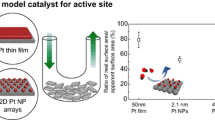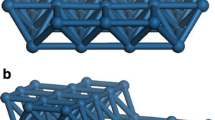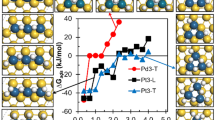Abstract
Associative desorption of hydrogen at edges and facets on Pt nano-particles (NPs) was studied using density functional theory. The goal was to identify catalytically active sites on Pt NPs for the hydrogen evolution reaction. Since NPs used in catalysis typically contain over a thousand atoms, calculations of whole particles are too demanding and the adsorption sites were instead modeled by periodic face centered cubic slabs representing an array of edges between two (111) micro-facets or edges between (111) and (100) micro-facets. The width of the facets in the periodic representations was systematically increased to reach converged results for binding and activation energy. For maximum hydrogen coverage, edges between (111) micro-facets were found to be several orders of magnitude more active than edges between (100) and (111) micro-facets or flat terraces. Unlike the missing row Pt(110)-(2 × 1) surface, which has sometimes been used as a simple model for edges between (111) micro-facets, the converged edge model does not show the recently reported reentrant behavior in desorption mechanism (Gudmundsdóttir et al., Phys Rev Lett 108:156101, 2012).







Similar content being viewed by others
References
Nørskov JK, Bligaard T, Rossmeisl J, Christensen CH (2009) Towards the computational design of solid catalysts. Nat Chem 1:37
Nørskov JK, Abild-Pedersen F, Studt F, Bligaard T (2011) Density functional theory in surface chemistry and catalysis. Proc Natl Acad Sci USA 108:937
Hvolbæk B, Janssens TVW, Clausen BC, Falsig H, Christensen CH, Nørskov JK (2007) Catalytic activity of Au nano-particles. Nano Today 2:14
Brodersen SH, Grønbjerg U, Hvolbæk B, Schiøtz J (2011) Understanding the catalytic activity of gold nano-particles through multi-scale simulations. J Catal 284:34
Christman K, Ertl G (1976) Interaction of hydrogen with Pt(111): the role of atomic steps. Surf Sci 60:365
Dahl S, Logadóttir A, Egeberg RC, Larsen JH, Chorkendorff I, Tørnqvist E, Nørskov JK (1999) Role of steps in N2 activation on Ru(0001). Phys Rev Lett 83:1814
Brouzgoua A, Songb SQ, Tsiakaras P (2012) Low and non-platinum electrocatalysts for PEMFCs: current status, challenges and prospects. Appl Catal B 127:371
Martin S, Martinez-Vazquez B, Garcia-Ybarra PL, Castillo JL (2013) Peak utilization of catalyst with ultra-low Pt loaded PEM fuel cell electrodes prepared by the electrospray method. J Power Sourc 229:179
Henry CR (1998) Surface studies of supported model catalysts. Surf Sci Rep 31:231
Narayanan R, El-Sayed MA (2005) Catalysis with transition metal nano-particles in colloidal solution: nanoparticle shape dependence and stability. J Phys Chem B 109:12663
Kleis J, Greeley J, Romero NA, Morozov VA, Falsig H, Larsen AH, Lu J, Mortensen JJ, Dulak M, Thygesen KS, Nørskov JK, Jacobsen KW (2011) Finite size effects in chemical bonding: from small clusters to solids. Catal Lett 141:1067
Gavnholt J, Schiøtz J (2008) Structure and reactivity of ruthenium nano-particles. Phys Rev B 77:035404
Lu C, Masel R (2001) The effect of ruthenium on the binding of CO, H2, and H2O on Pt(110). J Phys Chem B 105:9793
Cvetanovic R, Amenomiya Y (1967) In: Frankenberg W (ed) Advanes in catalysis, vol. 17. Academic Press 2 Inc., New York
Gudmundsdóttir S, Tang W, Henkelman G, Jónsson H, Skúlason E (2012) Local density of states analysis using Bader decomposition for N2 and CO2 adsorbed on Pt(110)-(1 × 2) electrodes. J Chem Phys 137:164705
Skúlason E, Karlberg GS, Rossmeisl J, Bligaard T, Greeley J, Jónsson H, Nørskov JK (2007) Density functional theory calculations for the hydrogen evolution reaction in an electrochemical double layer on the Pt(111) electrode. Phys Chem Chem Phys 9:3241
Rossmeisl J, Skúlason E, Björketun M, Tripkovic V, Nørskov J (2008) Modeling the electrified solidliquid interface. Chem Phys Lett 466:68
Skúlason E, Tripkovic V, Björketun ME, Gudmundsdóttir S, Karlberg G, Rossmeisl J, Bligaard T, Jónsson H, Nørskov JK (2010) Modeling the electrochemical hydrogen oxidation and evolution reactions on the basis of density functional theory calculations. J Phys Chem C 114:18182
Tripkovic V, Björketun ME, Skúlason E, Rossmeisl J (2011) Standard hydrogen electrode and potential of zero charge in density functional calculations. Phys Rev B 84:115452
Björketun ME, Tripkovic V, Skúlason E, Rossmeisl J (2013) Modeling of the symmetry factor of electrochemical proton discharge via the Volmer reaction. Catal Today 202:168
Björketun ME, Zeng Z, Ahmed R, Tripkovic V, Thygesen KS, Rossmeisl J (2013) Avoiding pitfalls in the modeling of electrochemical interfaces. Chem Phys Lett 555:145
Rossmeisl J, Chan K, Ahmed R, Tripkovic V, Björketun ME (2013) pH in atomic scale simulations of electrochemical interfaces. Phys Chem Chem Phys 15:10321
Karlberg GS, Jaramillo TF, Skúlason E, Rossmeisl J, Bligaard T, Nørskov JK (2007) Cyclic voltammograms for H on Pt(111) and Pt(100) from first principles. Phys Rev Lett 99:126101
Kohn W (1998) Nobel lecture: electronic structure of matter—wave functions and density functionals Rev Mod Phys 71:1253
Kresse G, Furthmüller J (1996) Efficient iterative schemes for ab initio total-energy calculations using a plane-wave basis set. Phys Rev B 54:11169
Hammer B, Hansen LB, Nørskov JK (1999) Improved adsorption energetics within density-functional theory using revised Perdew-Burke-Ernzerhof functionals. Phys Rev B 46:7413
Vanderbilt D (1990) Soft self-consistent pseudopotentials in a generalized eigenvalue formalism. Phys Rev B 41:7892
Jónsson H, Mills G, Jacobsen KW (1998) Nudged elastic band method for finding minimum energy paths of transitions. In: Berne BJ, Ciccotti G, Coker DF (ed) Classical and quantum dynamics in condensed phase simulations, World Scientific, Berkeley, pp 385
Henkelman G, Uberuaga B, Jónsson H (2000) A climbing-image NEB method for finding saddle points and minimum energy paths. J Chem Phys 113:9901
Henkelman G, Jónsson H (2000) Improved tangent estimate in the NEB method for finding minimum energy paths and saddle points. J Chem Phys 113:9978
Zhang Z, Minca M, Deisl C, Loerting T, Menzel A, Bertel E (2004) H on Pt(110): an atypical chemisorption site at low coverages. Phys Rev B 70:121401
Minca M, Penner S, Loerting T, Menzel A, Bertel E, Zucca R, Redinger J (2007) Chemisorption of hydrogen on the missing-row Pt(110)-(1 × 2) surface. Top Catal 46:161
Gudmundsdóttir S, Skúlason E, Jónsson H (2012) Reentrant mechanism for associative desorption: H2/Pt(110)-(1 × 2). Phys Rev Lett 108:156101
Gudmundsdóttir S, Skúlason E, Weststrate K-J, Juurlink L, Jónsson H (2013) Hydrogen adsorption and desorption at the Pt(110)-(1 × 2) surface: experimental and theoretical study. Phys Chem Chem Phys 15:6323
Olsen RA, Badescu SC, Ying SC, Baerends EJ (2004) Adsorption and diffusion on a stepped surface: atomic hydrogen on Pt(211). J Chem Phys 120:11852
Vehviläinen T, Salo P, Ala-Nissilä T, Ying SC (2009) Electronic properties of H on vicinal Pt surfaces: first-principles study. Phys Rev B 80:035403
Gee AT, Hayden BE, Mormiche C, Nunney TS (2000) The role of steps in the dynamics of hydrogen dissociation on Pt(533). J Phys Chem 112:7660
Engstrom JR, Tsai W, Weinberg WH (1987) The chemisorption of hydrogen on the (111) and (110)-(1 × 2) surfaces of iridium and platinum. J Chem Phys 87:3104
Lerch D, Klein A, Schmidt A, Müller S, Hammer L, Heinz K, Weinert M (2006) Unusual adsorption site of hydrogen on the unreconstructed Ir(100) surface. Phys Rev B 73:075430
Minca M, Penner S, Dona E, Menzel A, Bertel E, Brouet V, Redinger J (2007) Surface resonances on transition metals as low-dimensional model systems. New J Phys 9:386
Johansson M, Skúlason E, Nielsen G, Murphy S, Nielsen RM, Chorkendorff I (2010) Hydrogen adsorption on palladium and palladium hydride at 1 bar. Surf Sci 604:718
Kristinsdóttir L, Skúlason E (2012) A systematic DFT study of hydrogen diffusion on transition metal surfaces. Surf Sci 606:1400
Kubas GJ (2001) Metal dihydrogen and σ-bond complexes: structure, theory, and reactivity. Springer, Boulder
Yang F, Zhang Q, Liu Y, Chen S (2011) A theoretical consideration on the surface structure and nano particle size effect of Pt in hydrogen electrocatalysis. J Phys Chem C 115:19311
Acknowledgments
This work was funded in part by the Eimskip Fund of the University of Iceland, the Icelandic Research Fund and Nordic Energy Research by way of the Nordic Initiative for Solar Fuel Development. HJ acknowledges support from the Academy of Finland through the FiDiPro program. The calculations were in part carried out on the Nordic High Performance Computer (Gardar) located in Iceland.
Author information
Authors and Affiliations
Corresponding author
Rights and permissions
About this article
Cite this article
Skúlason, E., Faraj, A.A., Kristinsdóttir, L. et al. Catalytic Activity of Pt Nano-Particles for H2 Formation. Top Catal 57, 273–281 (2014). https://doi.org/10.1007/s11244-013-0182-3
Published:
Issue Date:
DOI: https://doi.org/10.1007/s11244-013-0182-3




